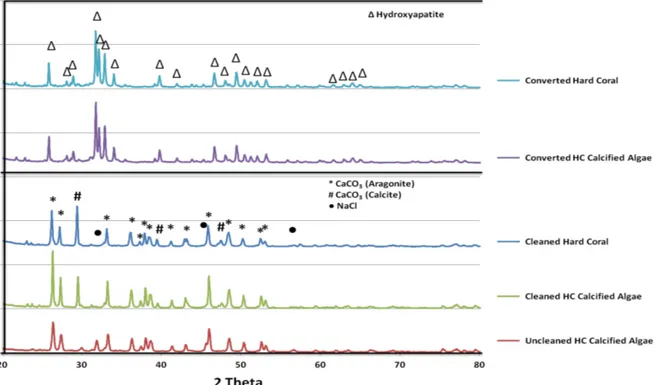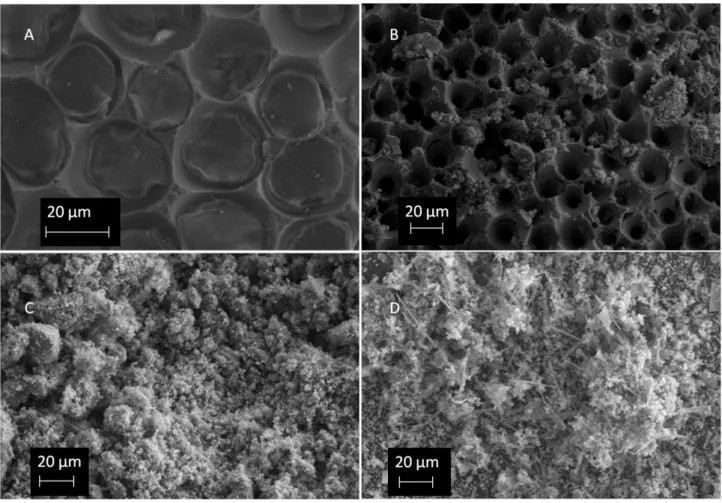OATAO is an open access repository that collects the work of Toulouse researchers and makes it freely available over the web where possible
Any correspondence concerning this service should be sent
to the repository administrator: tech-oatao@listes-diff.inp-toulouse.fr
This is an author’s version published in: http://oatao.univ-toulouse.fr/24483
To cite this version:
Choi, Gina and Karacan, Ipek and Cazalbou, Sophie and Evans, Louise and Sinutok, Sutinee and Ben-Nissan, Besim Conversion of Calcified Algae (Halimeda sp) and Hard Coral (Porites sp) to Hydroxyapatite. (2017) Key Engineering Materials, 758. 157-161. ISSN 1662-9795
Conversion of Calcified Algae (Halimeda sp) and Hard Coral (Porites sp)
to Hydroxyapatite
Gina Choi
1,a, Ipek Karacan
1,b*, Sophie Cazalbou
2,c, Louise Evans
1,d,
Sutinee Sinutok
3,4,eand Besim Ben-Nissan
1,f1University of Technology Sydney, Sydney, Broadway, New South Wales 2007, Australia. 2CIRIMAT Carnot Institute, CNRS-INPT-UPS, Faculty of Pharmacie, University of Toulouse,
France.
3Plant Functional Biology and Climate Change Cluster, School of the Environment, University of Technology Sydney, Sydney, Broadway, New South Wales 2007, Australia
4Faculty of Environmental Management, Prince of Songkla University, Kho Hong, Hat Yai, Songkla, Thailand
aGina.Choi@student.uts.edu.au, bIpek.Karacan@student.uts.edu.au,
cSophie.Cazalbou@univ-tlse3.fr, dLouise.Evans@uts.edu.au, eSsutinee@gmail.com, fBesim.Ben-Nissan@uts.edu.au
Keywords: Hydroxyapatite, calcium phosphate, hydrothermal conversion, calcified algae, coral
Abstract. Calcium phosphate materials can be produced using a number of wet methods that are based on hydrothermal or co-precipitation methods that might use acidic or basic chemical environments. In our previously published works, we have investigated calcium phosphates such as monetite, hydroxyapatite, and whitlockite which were successfully produced by mechano-chemical methods and/or hydrothermal treatments from a range of marine shells and corals which were obtained from the Great Barrier Reef. The aim of the current work was to analyze and compare the mechanisms of conversion of one hard coral species and one calcified algae species from the Great Barrier Reef.
Introduction
Hydroxyapatite (Ca10(PO4)6(OH)2; HAp) is often defined as being the constituent of the bone and teeth mineral phase [1]. As HAp and other calcium phosphate materials are osteoconductive, biocompatible and non-toxic, they make ideal substances to be used for biomedical and dental applications [1, 2].
HAp and other calcium phosphate bioceramics can be synthesized through a variety of wet chemical methods based on hydrothermal or co-precipitations [3, 4]. In these methods, the resulting phase is largely depending on the chemical and physical conditions. Alternatively, HAp can be synthesized through the conversion of biogenically derived minerals [5].
The exoskeletons of marine species, such as coral and calcified algae are composed of calcium carbonate (CaCO3) primarily in the form of aragonite [5, 6]. In previous research, calcium carbonates from coral and seashells have been successfully converted to hydroxyapatite through mechano-chemical and hydrothermal methods [7, 8]. An advantage of using these starting materials is the preservation of their porous morphologies, which resemble trabecular bone [5, 9, 10]. In hydrothermal treatment, the reagents are sealed in a reaction vessel, and are subjected to elevated temperatures and pressures. This method produces highly crystalline HAp with high phase purity [6].
Extensive research has been conducted on coral as a biomimetic material [5, 8, 9, 11-13]. However, harvesting coral causes extensive damage to coral reefs and consequently, the ecosystem [11, 10]. Alternatively, marine algae can potentially be used instead, as the harvesting procedures are less aggressive and will not destroy the surrounding seabed [10].
In this experiment, the calcareous green algae Halimeda cylindracea (Hc) harvested from the Great Barrier Reef was converted to HAp using hydrothermal conversion. Halimeda species are
distributed in tropical to sub-tropical environments. He consists of bead-like calcified segments linked together through a network of flexible fibers. These fo1m branching chains from a central base to produce a bushy thallus.
The aim of this experiment was to analyze and compare the conve1ied products for both hard coral (Porites sp) and He calcified algae species. The analysis was achieved by using powder X-ray diffraction (XRD) and Fourier transfo1m infrared spectroscopy (FT-IR) to characterize the materials before and after conversion. Fmiher analysis was done using scanning electron microscopy (SEM) to examine the microarchitecture of both species.
Materials and Method Mate rials
Hard coral (Porites sp) and Calcified Algae (Halimeda sp) samples were obtained from the Great
Barrier Reef, QLD, Australia. All chemicals used were from Sigma-Aldrich, Australia.
Synthesis and Characterization
He calcified algae was first cleaned using 2% (v/v) sodium hypochlorite (NaOCl) in an
ultrasonic water bath (UD80 SH-2L). Following this, He calcified algae was heat treated at 350°C
ovemight.
fu order to conve1i He calcified algae to HAp, diammonium hydrogen phosphate solution (�)2HP04) was prepared in 150 mL ultrapure water according to the Ca/P ratio of hydroxyapatite, 1.67. The clean He calcified algae was placed in a Parr reactor (Pan- fustmment, USA) with the �)2HP04 solution. The reaction vessel was sealed for 24 hours at a pressure of 8.0 MPa with the temperature adjusted between 160 - 220°C. The chemical reaction of the
hydrothe1mal reaction can be described by Eq. 1 below [12]:
lOCaC03 + 6�)2HP04 + 2H20--* Ca10(P04)6(0H)2 + 6(N�)2C03 + 4H2C03. (1) After conversion, the conve1ied product was washed with ultrapure water in a vacuum filter in order to remove excess �)2HP04 and was dried ovemight in an oven at 60°C. The same
procedure was applied for hard coral samples.
The analyses of materials were achieved using FTIR (The1mo-Scientific Nicolet 6700 instrument using ATR mode, from 2000 to 300 cm-1 at a resolution of 4 cm-1
), XRD (Bmker D8 Discover
diffractometer, radiation Cu-Ka 40 kV and 40 mA, from 20 to 80° 20, step size of 0.2° per
0.3 seconds) and SEM (Zeiss Evo LS15 scanning electi·on microscope with an accelerating voltage of 10 kV).
Results and Discussion
fu Fig.1, the differences between unclean-unconve1ied, clean-unconve1ied and conve1ied at 220°C He calcified algae samples can be seen clearly.
..
Figure 1: Unclean-unconve1ied (A), clean-unconve1ied (B) and conve1ied (C) H cylindracea.
The characterization of all samples was detennined by XRD analysis. The XRD patterns for whole samples are illusti·ated in Fig. 2. Although the major phase of unconverted He calcified and hard coral samples refers to aragonite material (JCPDS card No. 00-003-1067) which is a high pressure stable phase of calcium carbonate (CaC03), uncleaned-unconve1ied He calcified algae
contained one minor phase which was identified as NaCl. Additionally, clean-unconverted Hc calcified algae and hard coral samples which were dried at 350C° before conversion show some calcite ((JCPDS card No. 01-072-1650) peaks. Calcite is an atmospheric-pressure stable phase of CaCO3. Diffraction patterns of Hc calcified algae and hard coral show that the inorganic component of the marine samples have been converted to HAp (JCPDS card No. 00-009-0432) successfully.
Figure 2: XRD patterns of Unclean-unconverted, clean-unconverted and converted Hc and hard coral samples.
Certain calcium carbonate bands were illustrated in the FT-IR micrographs of uncleaned and cleaned unconverted samples which were completely similar to each other. Besides that, the characteristic absorption bands of HAp peaks in FT-IR spectrum of the converted Hc calcified algae and converted hard coral powders were proved to the hydrothermally conversion from calcium carbonate to HAp, succesfully in Fig.3.
Figure 3: FT-IR spectrum of unclean-unconverted Hc, clean-unconverted Hc, clean-unconverted hard coral, converted Hc and hard coral samples, respectively.
Figure 4: SEM images of clean-unconverted Hc calcified algae (A), converted Hc calcified algae (B), clean-unconverted hard coral powder (C), and converted hard coral powder (D). The microarchitecture of the samples were determined using SEM analysis. Examination of unconverted calcified algae under SEM revealed the microporous surface. (Fig 4-A, Fig. 4, B). Once converted, the microporous structure and pore distribution of the algae were retained. In addition to this, hydroxyapatite crystals with needle-like morphology were distributed on the algae surface. These observations are similar to those reported by Chou et al., who examined the distribution and architecture of pores in Foraminifera hard coral species [14]. Additionally, the SEM micrographs of unconverted and converted hard coral species are given in Fig. 4C and D respectively. In both micrographs, the coral powders are fine in nature. However after conversion, an additional phase of needle-like morphology is formed. As similar observations have been made for both converted calcified algae and hard coral powders, it can be concluded that rod-shaped crystals were formed through hydrothermal conversion. These crystals may be characterized as HAp according to XRD and FT-IR analysis.
Conclusion
Calcified algae H. cylindracea and hard coral Porites sp. were successfully converted to hydroxyapatite with a Parr hydrothermal reactor. The materials were characterized using XRD and FT-IR analysis, and the microarchitecture was observed using SEM. It was shown that H. cylindracea contains a large amount of organic matter that allows flexibility but requires longer cleaning periods and conversion times than hard corals. The unique morphology of these materials may permit drug loading and long term slow and sustained drug delivery.
References
[1] S. V. Dorozhkin, Bioceramics of calcium orthophosphates, Biomaterials. 31 (2010) 1465-1485. [2] R. Li, Dimensionally and morphologically controlled growth of calcium phosphate crystals by an organic-free hydrothermal process, Ceram. Int. 42 (2016) 17387-17397.
[3] J. Torrent-Burgues, R. Rodriguez‐Clemente, Hydroxyapatite Precipitation in a Semibatch Process, Cryst. Res. Technol. 36 (2001) 1075-1082.
[4] J. Liu, X. Ye, H. Wang, M. Zhu, B. Wang, H. Yan, The influence of pH and temperature on the morphology of hydroxyapatite synthesized by hydrothermal method, Ceram. Int. 29 (2003) 629-633.
[5] B. Ben-Nissan, Natural bioceramics: from coral to bone and beyond, Curr. Opin. Solid State Mater. Sci. 7 (2003) 283-288.
[6] N. Mohan, R. Palangadan, H. Varma, Hydroxyapatite scaffolds constituting highly oriented crystals derived from synthetic precursors by hydrothermal reactions, Ceram. Int. 42 (2016) 17259-17268.
[7] J. Chou, R. Samur, L. S. Ozyegin, B. Ben-Nissan, F. N. Oktar, I. J. Macha, An alternative synthesis method for di calcium phosphate (Monetite) powders from mediterranean mussel (Mytilus galloprovincialis) shells, J. Aust. Ceram. Soc. 49 (2013) 122–128.
[8] I. J. Macha, U. Boonyang, S. Cazalbou, B. Ben-Nissan, C. Charvilat, F. N. Oktar, D. Grossin, Comparative study of Coral Conversion, Part 2: Microstructural evolution of calcium phosphate, J. Aust. Ceram. Soc. 51 (2015) 149-159.
[9] M. Sivakumar, T. S. S. Kumar, K. L. Shantha, K. P. Rao, Development of hydroxyapatite derived from Indian coral, Biomaterials. 17 (1996) 1709-1714
[10] G. Felício-Fernandes, M. Laranjeira, Calcium phosphate biomaterials from marine algae. Hydrothermal synthesis and characterization, 'Quím. Nova, 23 (2000) 441-446
[11] D. W. Green, B. Ben-Nissan, K. S. Yoon, B. Milthorpe, H. Jung, Natural and Synthetic Coral Biomineralization for Human Bone Revitalization, Trends Biotechnol., 35 (2017) 43-54
[12] J. Hu, J. J. Russell, B. Ben-Nissan, R. Vago, Production and analysis of hydroxyapatite from Australian corals via hydrothermal process, J. Mater. Sci. Lett. 20 (2001) 85-87
[13] D. M. Roy, S. K. Linnehan, Hydroxyapatite formed from Coral Skeletal Carbonate by Hydrothermal Exchange, Nat. 247 (1974) 220-222
[14] J. Chou, J. Hao, B. Ben-Nissan, B. Milthorpe, M. Otsuka, Coral Exoskeletons as a Precursor Material for the Development of a Calcium Phosphate Drug Delivery System for Bone Tissue Engineering, Biol. Pharm. Bull. 36 (2013) 1662-1665.


